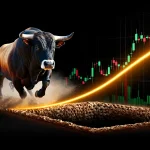
Compromise Effect vs Decoy Effect: Unmasking the Hidden Forces That Shape Our Choices
Feb 10, 2025
Have you ever questioned the true freedom of your choices? In a world meticulously engineered to manipulate our decisions at every turn, the compromise effect and the decoy effect stand as silent puppeteers. These cognitive influences govern our consumer purchases and penetrate deep into our investment strategies. Today, we delve into their intricate workings, exploring how timeless wisdom meets cutting-edge investing insights to challenge conventional thinking and empower you to reclaim your decision-making prowess.
As we embark on this intellectual journey, consider this: while you may believe that your selections are the products of rational evaluation, the underlying forces of behavioural economics are gently, yet decisively, steering your choices. With every financial commitment and every investment decision, the dynamics of the compromise effect and decoy effect are at play, subtly guiding your preferences. This essay seeks to unmask these hidden forces and provide you with actionable insights to navigate the complexities of modern markets with confidence and clarity.
Understanding the Compromise Effect: The Middle Ground as a Beacon of Safety
The compromise effect is a powerful cognitive bias where decision-makers lean towards the middle option among a range of alternatives. It suggests that individuals will often choose a product or a service that appears to be a ‘safe’ compromise between two extremes, thereby minimising the risk of making an abject error. This tendency to opt for moderation is not merely a quirk of consumer choice; it is a reflection of our intrinsic need for balance, particularly when faced with a multitude of options that vary significantly in price or quality.
At its core, the compromise effect implies that when presented with several alternatives, the middle option carries an implicit endorsement of being the most ‘reasonable’ choice. For instance, imagine you are evaluating three investment opportunities: one extremely risky with potentially high returns, one extremely conservative offering modest gains, and a third option that lies comfortably in between. The human mind, wary of both excessive risk and minimal reward, often gravitates towards the middle-ground option. In this way, the compromise effect becomes a guardian of our decision-making, saving us from erratic swings and undue risk-taking by embracing a more measured, balanced stance.
This cognitive bias is not only a matter of psychological intrigue but also serves as a strategic consideration in investing. When investors encounter market environments characterised by volatility and uncertainty, the middle-ground strategy can emerge as a stabilising force. By acknowledging the allure of compromise, one can learn to benchmark choices against objective criteria rather than succumbing to the seductive trap of extremes. In recognising this effect, you begin to see that the safest path is not always the most lucrative one, but it is often the one that best aligns with a disciplined, long-term vision.
Dissecting the Decoy Effect: The Power of a Superfluous Competitor
If the compromise effect is the allure of the middle ground, the decoy effect is the artful placement of a seemingly inferior option to influence decision-making. This phenomenon occurs when an additional option (the decoy) is introduced to sway preferences toward one of the existing choices. The decoy is strategically designed to be less attractive, making one of the other options appear far more appealing by comparison.
In everyday scenarios, the decoy effect is employed across various markets. Consider a scenario where a retailer offers three product packages: the basic, the premium, and a decoy package that is hardly as well-equipped as the premium option yet is priced too close to it. With the decoy in place, consumers find themselves nudged towards the premium option, which now represents a disproportionately superior value. The decoy effect manipulates our innate tendency to draw comparisons, thereby distorting our perception of true worth.
This mechanism extends its influence into the world of investments. Imagine an investor who is offered two funds: one with moderate returns and acceptable risk, and another with high risk and potentially exceptional returns. By introducing a third, substandard fund that does not measure up to the high-risk alternative but is more expensive than the moderate one, advisors can subtly steer investors towards the more attractive high-risk option. Thus, an understanding of the decoy effect can serve not only as a cautionary tale but also as a weapon in the arsenal of the savvy investor who wishes to attain a contrarian edge over the herd.
Both the compromise and decoy effects reveal the profound ways in which external cues and contextual framing can dictate our choices. Recognising these influences empowers you to challenge conventional wisdom and to question the legitimacy of options presented as mutually exclusive or pre-determined. In doing so, you cultivate a mindset that is uniquely attuned to spotting manipulation in its many guises—be it in a bustling marketplace or the cutthroat arena of stock trading.
Mass Psychology and Cognitive Biases: The Underlying Tapestry of Decision-Making
The dynamic interplay of the compromise and decoy effects is deeply embedded in the broader canvas of mass psychology. Our decision-making processes are governed by a host of cognitive biases—loss aversion, overconfidence, anchoring, and the bandwagon effect, to name but a few. These mental shortcuts, though evolutionary in nature, often lead us astray when absolute rationality is required.
Loss aversion, for example, compels us to fear the pain of a loss more acute than the pleasure derived from an equivalent gain. This bias makes us hesitant to part with our investments, even when continuing to invest further is clearly a losing proposition. Similarly, anchoring induces us to fixate on an initial piece of information—often the first price or value encountered—thus skewing subsequent judgements, regardless of evolving circumstances.
When investors are gripped by such biases, the market becomes a theatre of collective irrationality where herd mentality prevails. The decoy effect and compromise effect are but two manifestations of this greater phenomenon. They illustrate how subtle manipulations in presentation can set off cascading effects, leading to decisions that defy conventional logic and undermine long-term objectives. In recognising this interplay, you not only gain insight into your own decision-making pitfalls but also expose opportunities where contrarian strategies may flourish. This awareness equips you to differentiate between true value and superficially attractive options engineered to trigger an automatic and often detrimental response.
Philosophers and economists alike have warned of the perils of succumbing to mass psychology. The reckless exuberance witnessed in speculative bubbles and the crippling inertia during market panics are reminders of how far our emotional wiring can carry us from rationality. By grounding oneself in methodical analysis and embracing an unwavering commitment to objective criteria, you elevate decision-making from the realm of instinct to that of disciplined strategy. This fundamental transformation in thinking is the essence of what it means to engage the modern market with both eyes wide open.
Modern Investing Insights: Navigating Volatility with Strategic Acumen
In today’s investment landscape, characterised by relentless volatility and rapid technological change, understanding cognitive biases is not a theoretical luxury—it is a practical necessity. The strategies employed by seasoned investors illustrate that embracing the lessons of the compromise and decoy effects can transform risk into opportunity. For instance, in times of market turmoil, the very forces that trigger mass panic also unveil corridors of potential brilliance for the contrarian investor.
One such strategy is the art of counter-intuitive asset allocation. When faced with overwhelming market sentiment that drives prices to unsustainable heights or plunges them to unjustifiable lows, independence of thought becomes your most valuable asset. By resisting the allure of trendy options swayed by the decoy effect, you are better equipped to identify investments that are undervalued relative to their intrinsic worth. The key is to decipher the contextual frame in which investment options are presented: is the premium attached to a particular asset merely a product of skillful decoy placement, or does it reflect an enduring quality that justifies its valuation?
Furthermore, cutting-edge techniques such as algorithmic trading and quantitative analysis provide objective tools that help filter out the noise of mass psychology. These technologies allow you to scrutinise technical indicators like the Relative Strength Index (RSI) and Moving Average Convergence Divergence (MACD) divergence, offering clarity amid market chaos. Yet, even amidst the sophistication of modern finance, the core challenge remains the same: to recognise and overcome the cognitive biases that colour every market decision.
The modern investor must operate with the clarity of an ancient philosopher and the analytical acumen of a cutting-edge technologist. This hybrid approach is critical when charting a course through turbulent markets. Strategies such as selling puts on blue-chip stocks during periods of panic—thereby collecting inflated premiums—and using these premiums to bolster long-term positions exemplify how contrarian tactics can yield impressive returns. Such strategies throttle the momentum of mass psychology by grounding investment decisions in calculated risk management, ensuring that the seductive power of the decoy or compromise effects does not derail thoughtful planning.
Timeless Wisdom Meets Contemporary Investing: Lessons from the Past for a Better Future
Throughout history, wisdom has spoken to the perennial human condition—our struggles, our triumphs, and our fallibilities. Ancient philosophers extolled the virtues of self-awareness and rational deliberation, lessons that remain remarkably relevant today. The insights they provided are remarkably prescient when applied to the modern conundrum of decision-making in investment. The Greeks, in their quest for knowledge, recognised that human nature is as susceptible to illusion as it is to reason. Today, these timeless insights find a new battlefield in the financial markets, where the compromise effect and decoy effect manipulate the choices of millions.
Consider the doctrine of Stoicism, which teaches the cultivation of inner resilience and the pursuit of rationality despite external turbulence. This philosophy is a potent antidote to impulsive decision-making influenced by extraneous factors. When market sentiment swings wildly—propelled by the decoy effect’s deceptive allure or the safety of the compromise effect—Stoic wisdom reminds us to maintain equanimity. The disciplined investor, much like the tempered philosopher, knows that emotional detachment is not an abdication of passion but, rather, the steadfast commitment to clarity and truth in one’s decision-making process.
Modern investing does not require the renunciation of emotion but necessitates its rigorous management. When you combine ancient philosophical insights with contemporary analytical tools, you forge a methodology that is both robust and adaptive. By anchoring yourself in timeless truths—recognising that the true measure of worth can only be discerned through disciplined scrutiny—you develop an unwavering conviction that transcends the ephemeral allure of market hype. This synthesis of old and new not only separates the true investor from the herd but fortifies your resolve to act with conviction, even when the tide of popular opinion threatens to overwhelm reason.
Actionable Strategies to Combat Cognitive Manipulation and Secure Your Financial Future
Empowerment in investing stems from the confluence of knowledge, strategic awareness, and the courage to defy conventional norms. To counteract the subtle sway of compromise and decoy effects, proactive measures must be taken. First, cultivate an environment where regular, unbiased reviews of your investments are paramount. Establishing predetermined criteria for assessing performance—unclouded by emotion—ensures that you do not inadvertently fall prey to cognitive traps.
Develop a systematic approach to decision-making. This might involve leveraging data analytics and quantitative methods to rigorously test assumptions and validate investment choices. By instituting a regimen of regular portfolio reviews, you create opportunities for recalibration, allowing you to isolate signals from the noise of market hype. One effective tactic is the practice of dollar-cost averaging, which naturally mitigates the impact of market volatility. This discipline enables you to accrue positions gradually, reducing the risk associated with trying to time the market—a temptation often amplified by the decoy effect’s allure.
Moreover, diversifying beyond traditional asset classes serves as a robust countermeasure to behavioural biases. As you allocate resources to a spectrum of investments—ranging from stable, blue-chip stocks to emerging technologies—you inherently dilute the influence of any single market sentiment. Complement this strategy with contingency planning; for instance, establishing stop-loss orders or setting clear exit thresholds can safeguard your investments from the corrosive effects of prolonged market inertia. By approaching every decision with a balance of rational analysis and measured risk-taking, you weave resilience into your financial strategy.
Finally, never underestimate the importance of continuous learning. Immerse yourself in financial literature, stay abreast of market trends, and engage with a community of thoughtful, like-minded investors. The learning journey not only sharpens your analytical skills but also reinforces your ability to critically evaluate new information—a critical antidote to the seductive influence of the compromise and decoy effects. In doing so, you transform each market challenge into an opportunity for intellectual and financial growth.
Conclusion: Reclaim Your Decision-Making Power with Clarity and Conviction
In the relentless push and pull of market forces, the compromise effect and decoy effect emerge as ubiquitous influencers, orchestrating our choices with subtle yet powerful precision. Yet, awareness of these cognitive forces opens the door to a realm of strategic possibility. Armed with timeless wisdom and a passion for analytical rigour, you have the opportunity to redefine what it means to make a choice—in investing and life.
Reject the notion that your decisions must be the product of unexamined impulses. Instead, embrace the role of an active, informed decision-maker who blends the stoic calm of ancient philosophy with the dynamic insights of contemporary finance. By recognising the interplay of mass psychology, embracing counterintuitive strategies, and committing relentlessly to objective analysis, you can overcome the manipulative allure of external cues.
Take these actionable strategies to heart: implement systematic reviews, deploy quantitative decision-making tools, diversify your investments, and continuously challenge conventional perceptions. In doing so, you reclaim the power of choice from the covert grip of biases and set forth on a path that promises not only superior financial outcomes but also a deeper, more resilient sense of personal empowerment. Let your investment decisions be a testament to clarity, critical thought, and a steadfast commitment to the truth.
Let this be the moment you choose not to be led by unseen forces but to master them, turning every decision into a beacon of informed strategic brilliance.










